Abstract
Cerium oxide (CeO2) nanoparticles were synthesized with a chemical precipitation method in different experimental conditions using cerium nitrate hexahydrate (Ce(NO3)3·6H2O) as a precursor, modifying the solution pH, the reaction time, and Co atoms as dopants, in order to tune the band gap energy values of the prepared samples. The physical characteristics of the synthesized ceria nanoparticles were evaluated by Fourier transform infrared (FT-IR) spectroscopy, X-ray diffraction (XRD), scanning electron microscopy (SEM), transmission electron microscopy (TEM), UV–Vis analyses and photoluminescence measurements. XRD data revealed a pure cubic fluorite structure of CeO2 NPs, the estimation of crystallite sizes by Scherrer’s formula indicates the formation of crystals with dimensions between 11.24 and 21.65 nm. All samples contain nearly spherical CeO2 nanoparticles, as well as cubic, rhomboidal, triangular, or polyhedral nanoparticles that can be identified by TEM images. The optical investigation of CeO2 samples revealed that the band gap energy values are between 3.18 eV and 2.85 eV, and, after doping with Co atoms, the Eg of samples decreased to about 2.0 eV. In this study, we managed to obtain CeO2 NPs with Eg under 3.0 eV by only modifying the synthesis parameters. In addition, by doping with Co ions, the band gap energy value was lowered to 2.0 eV. This aspect leads to promising results that provide an encouraging approach for future photocatalytic investigations.
1. Introduction
The synthesis of ceria nanoparticles (CeO2 NPs) of various sizes and shapes was thoroughly investigated in recent research due to their promising chemical and physical properties and their potential applications as catalysts [1,2,3,4], ultraviolet absorbers [5], oxygen sensors [6], or storage systems [7,8]. The physicochemical features of ceria nanoparticles are closely related to their crystalline structure, the reason for this is that, over time, different techniques have been developed to synthesize CeO2 nanoparticles, such as hydrothermal technique [9,10], sol–gel method [11,12], precipitation [13,14], solvothermal [15], microemulsion [16], microwave [17] methods, or their combination [18,19]. Depending on the chosen synthesis method, the size, shape, and crystallinity of the nanoparticles are modified as a function of the synthesis parameters, namely the reactant concentration, reaction time and temperature, solution pH, and the use of surfactants [10,20,21,22,23,24,25]. Generally, the synthetic methods are preferred because they provides convenient attributes, such as short preparation time, low reaction temperature and low cost, high purity and homogeneity of the resulting particles, and well-crystallized products with predictable size and morphology [26,27,28,29].
If CeO2 nanoparticles are intended for photocatalytic applications, an extreme importance is credited to the optical properties and especially to the band gap value, which dictates the potential use of nanoparticles in the UV or visible field. It is well documented that CeO2 NPs can display a wide band gap energy of 2.6 to 3.4 eV [1,30,31], which can be modulated by the preparation method; moreover, it was proved that it depends on the presence of oxygen vacancies and Ce3+ ions [9,32,33].
Another option to improve the photocatalytic activity of CeO2 in terms of band gap decrease refers to rare earth or transition metal doping [34,35], which could induce the formation of lattice defects able to selectively tune the electronic structure of CeO2 by a better separation of h+/e− pairs, leading to the enhanced absorption of visible light [35,36]. The improvement of optical and catalytic properties induced by metal ion doping is very sensitive to their structural and electronic properties, thus there are many factors such as the nature of the dopant, synthesis route, size, morphology, band gap, and the type of defects responsible for tuning the photonic characteristics [35,36,37].
In this context, the paper focuses on the synthesis of CeO2 NPs in diverse preparative conditions (pH, time, co-reagent variation), followed by a methodical characterization, in order to evaluate their structural, morphological, and optical attributes, with an emphasis on the most accurate correlation of structural, optical, and morphological results. Our attention was especially focused on the modulation of the band gap energy of CeO2 NPs in order to facilitate a better harvesting of light, especially visible light, in various photocatalytic processes. Thus, in an attempt to enlarge the photocatalytic activity of the prepared nanoparticles, we succeeded to demonstrate that CeO2 NPs with the desired Eg values (under 3.0 eV) can be easily obtained only by a convenient modification of the synthesis parameters and that, in addition, by doping with Co ions, the band gap energy value was lowered to 2.0 eV. The performed investigations will allow us to select the optimal synthesis parameters for the preparation by a facile method of CeO2 NPs, promising for photocatalytic application under sunlight, with predictable values of Eg, sizes and a slow recombination rate of charge carriers.
2. Materials and Methods
2.1. Materials and Reagents
Cerium nitrate hexahydrate (Ce(NO3)3·6H2O), cobalt nitrate hexahydrate (Co(NO3)2·6H2O), ammonia solution 25%, NaOH, terephthalic acid, and ethanol 96% were purchased from Sigma–Aldrich Co. (Taufkirchen, Germany) and used as received. Deionized water was used in the experiments and in the preparation of the solutions.
2.2. Preparation of CeO2 Nanoparticles
2.2.1. Synthesis of CeO2 Nanoparticles V1, V2 and V3
The first series of CeO2 NPs discussed in this study was synthesized according to a procedure reported in the literature by Podasca et al. for the synthesis of ZnO nanoparticles [38]. Thus, the synthesis steps for the preparation of V1 NPs were as follows: in a 500 mL round bottomed flask fitted with a mechanical stirrer, 6 g (14 mmol) cerium nitrate hexahydrate was dissolved in 350 mL deionized water. Ammonia solution (25%) was then added into the cerium solution under magnetic stirring until pH = 8, and the reaction mixture was left stirring for 3h at 85 °C. The precipitate was centrifuged, washed with deionized water, and dried at room temperature for 1 day, and then the dried sample was calcined at 600 °C for 3 h. In the preparation of V2 NPs, the solution was adjusted to pH 10 using ammonia (25%); the rest of the synthesis protocol remaining unchanged. For the preparation of V3 NPs, the reaction mixture at pH = 10 was heated at 85 °C for 72 h.
2.2.2. Synthesis of CeO2 NPs by Version 2 (V4)
This synthesis was realized by using a similar method as Dong and co. [39], though with a few modifications. In a 100 mL bottomed flask fitted with a mechanical stirrer, 1.74 g (4 mmol) cerium nitrate hexahydrate was dissolved in 40 mL deionized water and, under vigorous stirring, 0.3 M solution of sodium hydroxide was dropwise added up to pH 12. The solution was heated at 100 °C and was maintained at this temperature for 3 h in order to allow the formation of CeO2 particles. When cooled down to room temperature, the precipitate was centrifuged, washed with deionized water, dried at room temperature for 1 day, and the sample was calcined at 600 °C for 3 h.
2.2.3. Synthesis of CeO2 NPs by Version 3 (V5, V6)
This synthesis protocol was adapted from Li et al. [40]. Thus, 1.74 g (4 mmol) cerium nitrate hexahydrate and 0.66 g (4 mmol) terephthalic acid were dissolved in a 1:1 ethanol-water solution (200 mL, v/v = 1:1) under vigorous stirring at room temperature. Then, the stirring of the solution was continued for 3 h at 90 °C until the formation of a white precipitate was noticed. Further, the temperature of the reaction mixture was reduced to 24 °C, the formed precipitate was collected by centrifugation, and, for an additional purification, was washed several times with water and ethanol, followed by overnight drying in an oven at 60 °C. The resulting product was calcined at 600 °C in air atmosphere for 3 h and the V5 sample was achieved. For the synthesis of V6 NPs, the same protocol was followed, except that the stirring of the reaction mixture was prolonged by up to 72 h at a temperature of 90 °C.
2.3. Preparation of Co-Doped CeO2 Nanoparticles (V2-Co and V5-Co)
For the synthesis of Co-doped CeO2 NPs, V2 and V5 samples were selected. The same synthesis pathway as for the undoped samples was pursued, except that, initially, the reaction mixtures contain in each case a 9:1 molar ratio of Ce(NO3)3·6H2O: Co(NO3)2·6H2O. For an easier identification of the samples, the preparation conditions are summarized in Table 1.

Table 1.
Experimental parameters for the preparation of undoped/doped CeO2 nanoparticles.
2.4. Characterization
Bruker Vertex 70 FTIR spectrophotometer (BRUKER, Karlsruhe, Germany) was used to register the Fourier transform infrared (FTIR) spectra on KBr pellets in the spectral domain 400–4000 cm−1. For the evaluation of the crystalline structure of CeO2 NPs, a Rigaku Miniflex 600 X-ray diffractometer (Tokyo, Japan) was employed. The diffractometer used Cu Kα radiation (λ = 1.5406 Å) and the measurements were performed in the range 2θ = 20.0°–90.0°, in steps of 0.01° and a recording rate of 1°/min. To calculate the average crystallite size of CeO2 NPs from the XRD diffractograms, the Scherrer equation was applied. The size and morphology of CeO2 NPs were investigated on a HITACHI T7700 transmission electron microscope (TEM) (Tokyo, Japan) at an accelerating voltage of 120 kV. For the analysis, CeO2 NPs were deposited from an ethanol solution on a carbon-coated copper grid. The agglomeration of ceria particles on the copper grid can be a consequence of the drying process. The surface morphology and energy-dispersive X-ray spectroscopy (EDX) investigations were carried out on a Verios G4 UC scanning electron microscope (Thermo Fisher Scientific, Brno, Czech Republic) coupled with an energy dispersive spectrometer (EDS, EDAX Octane Elite). For high-quality SEM images, the investigated NPs were sputter coated with a thin layer of platinum of 6 nm. For the measurement of the optical properties of the samples, CeO2 NPs (pristine and Co-doped) were rigorously dispersed in ethanol (1 mg/10 mL) by sonication for 30 min. Further, the UV–Vis absorption spectra were recorded for each solution in the wavelength domain 200–1000 nm using a Perkin Elmer Lambda 2 UV–Vis spectrophotometer (Perkin Elmer Inc., Wellesley, MA, USA). The reflectance spectra of the pristine and Co-doped CeO2 NPs were also measured in the wavelength domain 300–1000 nm. The photoluminescence spectra at different excitation wavelengths (270 and 325 nm) were registered on an RF-6000 Shimadzu spectrofluorometer (SHIMADZU, Korneuburg, Austria).
3. Results and Discussion
3.1. Structural and Morphological Characterization
The FTIR spectra of the prepared samples in the range of 4000–400 cm−1 are illustrated in Figure 1. In all spectra, a large band with a maximum at around 3435 cm−1, accompanied by another band centered at ~1632 cm−1, are visible, and may be attributed respectively to the stretching and bending mode of the physisorbed water molecules in the samples. The wide absorption band at around 400–600 cm−1 can be attributed to Ce–O stretching vibrations, and it confirms the formation of CeO2 particles. The other absorption bands present in all IR spectra might be assigned to various absorbing species (carbonate-type species such as atmospheric CO2, for example, which could interact with the cerium cations at 1000–1200 cm−1 or the band at 1385 cm−1 given by the stretch of N–O linkages coming from nitrate precursors) [23,41]. Although the samples were calcined at 600 °C after preparation, absorption bands located in the 2800–3000 cm−1 region are visible in all FTIR spectra and can be assigned to C–H hydrocarbon stretching and are a measure of ceria reactivity at the surface level [23] or can be associated to the presence of some residual organic molecules [42].
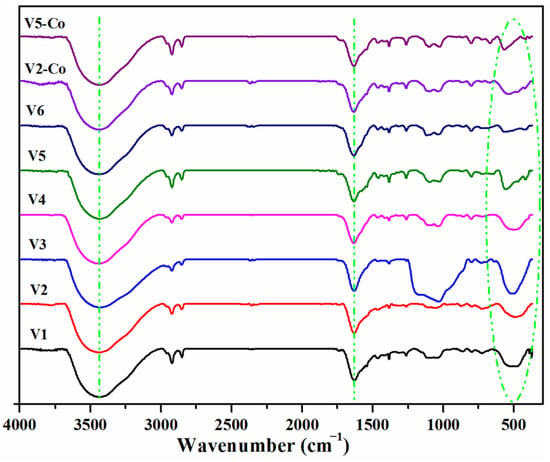
Figure 1.
FTIR spectra of CeO2 nanoparticles prepared using various synthesis methods.
The phase purity of CeO2 NPs was evaluated by XRD, and the recorded patterns were illustrated in Figure 2. As can be seen in the figure, the diffraction peaks observed in the 2θ range from 20° to 90° (2θ = 28.63, 33.17, 47.60, 56.44, 59.22, 69.50, 76.82, 79.18, 88.55) can be associated with (111), (200), (220), (311), (222), (400), (331), (420), and (422) planes, respectively, and share a close resemblance to literature data for CeO2 NPs (JCPDS 43-1002) corresponding to the pure cubic fluorite structure of CeO2. Moreover, in the doped samples, the absence of any extra diffraction peaks attributable to cobalt oxides suggests the isomorphic replacement of cerium by cobalt cations in the cubic lattice or their high dispersion in the ceria crystals [43].
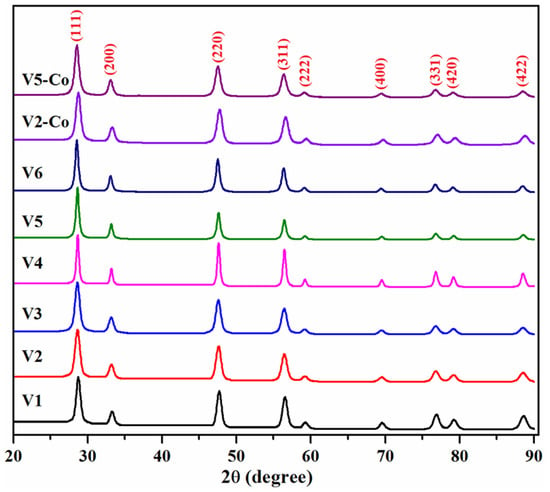
Figure 2.
XRD patterns of CeO2/Co-doped CeO2 nanoparticles.
The estimation of the crystallite sizes of the samples was performed using Scherrer’s formula, d = Kλ/βcosθ, where d is the crystallite size, K is the so-called shape factor, which usually takes a value of about 0.9, λ is the X-ray wavelength of the radiation source (1.5406 Å), β is the full-width at half-maximum (FWHM) of the diffraction peak, and θ is the Bragg angle. The crystal size varies between 11.24 and 21.65 nm (Table 2). The nanoparticles with smallest crystallite sizes (~11–12 nm) were obtained through the reactions achieved at pH 8 and 10 (V1–V3 samples), while the pH variation at more extreme values (4 or 12) leads to a doubling of the crystallite dimension (~20 nm) of the nanoparticles (V4–V6 samples). If CeO2 NPs are intended to be use as photocatalysts, the ones with a smaller crystallite size are preferred, since the charge migration pathway to the surface is reduced compared to the ones with larger dimensions, thus resulting in a decrease in the recombination rate of the charge carriers [44,45]. Moreover, it can be observed that the increase in the reaction time (in the case of V3 and V6 samples) does not cause a significant change in the size of the crystallites. The inclusion of Co atoms in the V2 sample does not notably influence the crystallites’ growth, while, for sample V5-Co, a decrease in the crystallite size was observed, a finding that could be attributed to the replacement of Ce ions with Co-dopant ions, as previously reported by Ranjith et al. [46].

Table 2.
Crystallite size (nm), average particle size (TEM, nm), and optical parameters (λabs, Eg) of pristine and Co-doped CeO2 NPs.
The morphology and elemental composition of Ceria and Co-doped CeO2 nanoparticles were investigated by SEM-EDX analysis; Figure 3a–d displays representative images for the V2 (Figure 3a,c) and V2-Co (Figure 3b,d) samples. As shown in Figure 3a,b, the prepared nanoparticles are characterized by a uniform spherical morphology that had not been significantly altered by doping with cobalt. To investigate the surface chemical composition of the materials, energy dispersive X-ray (EDX) analysis was performed. As shown in Figure 3c, on the surface of V2 sample, Ce and O elements (the peak for Pt being attributed to the sputter coating of the samples with a Pt layer) were identified. The EDX spectrum of the V2-Co sample (Figure 3d) confirms the existence of Co atoms in the CeO2 particles.
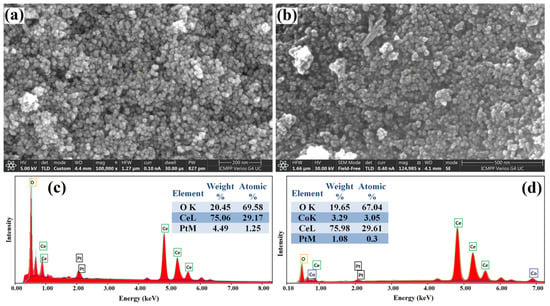
Figure 3.
SEM images of V2 (a) and V2-Co (b) samples and EDX elemental analysis spectra of V2 (c) and V2-Co (d).
The morphology of the synthesized CeO2 NPs was also analyzed by TEM microscopy and the corresponding TEM images are shown in Figure 4.
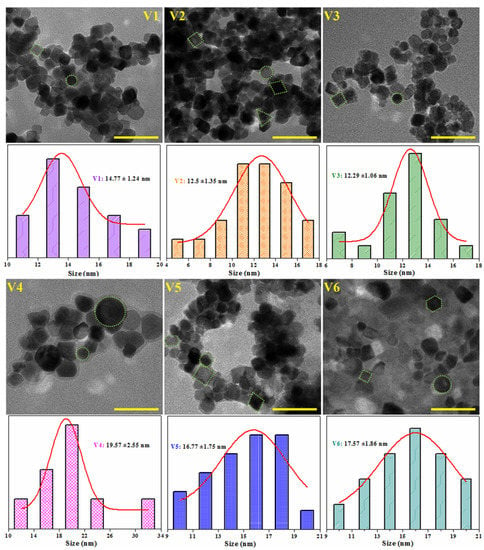
Figure 4.
TEM images of CeO2 nanoparticles and the corresponding particle size distribution. Scale bar is 50 nm.
As illustrated in the figure, in general, CeO2 nanoparticles have a narrow dimensional distribution, with crystal diameters between 12 and 20 nm (Table 2); however, a significant aggregation of individual units can be observed in the displayed microscopic images, which could be attributed to the deposition and drying process on copper holders [47]. All samples contain nearly spherical CeO2 nanoparticles, but cubic, rhomboidal, triangular, or polyhedral nanoparticles are also visible by TEM images. The largest inhomogeneous NPs are observed in the V4 sample (see the associated histogram in Figure 4), demonstrating that an increase in pH value is not favorable to the formation of nanoparticles with uniform size distribution. The estimated nanoparticle size resembles the crystallite size calculated from XRD data using Scherer’s formula (Table 2), sustaining once again that the V1–V3 samples (prepared at pH 8 and 10) are more dimensionally appropriate to be used as catalysts.
After cobalt doping, the morphology of the V2-Co nanoparticles is modified, observing the formation of nanoparticles with uneven size distribution (between 7 and 15 nm) and irregular structure (Figure 5), suggesting that cobalt ions influence the nanoparticles’ formation, especially in terms of their shape. Regarding the V5-Co sample, the estimated nanoparticles’ diameters ranged from 6 to 16 nm, exhibiting a good dimensional and shape homogeneity. It is evident that the addition of cobalt dopant can obstruct the growth of CeO2 crystalline domains in both cases, indicating the appearance of some distortions at the atomic level caused by Co ions [34], as also remarked in the XRD analysis. This finding may represent a positive effect on the photocatalytic performance of the Co-doped nanoparticles.
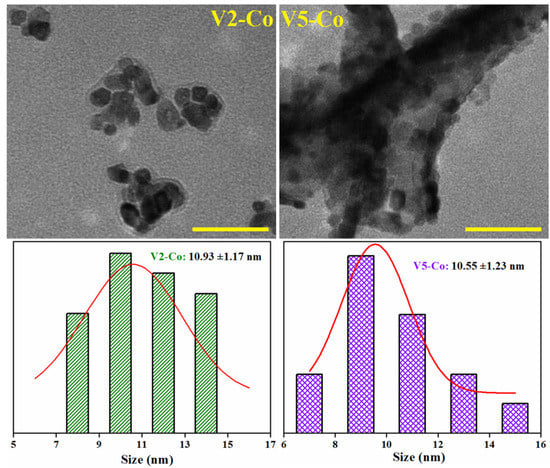
Figure 5.
TEM images of Co-doped CeO2 nanoparticles and the corresponding particle size distribution. Scale bar is 50 nm.
3.2. Optical Study of Pristine and Co-Doped CeO2 NPs
Optical properties of the synthesized CeO2 NPs were studied with UV–Vis spectroscopy by measuring the absorbance and reflectance spectra of all samples at room temperature over a wavelength range of 200–1000 nm. Figure 6 presents the UV–Vis absorption spectra of pristine CeO2 NPs, namely V1–V6, and it can be observed that the prepared samples show a strong absorbance band in the UV range (296–340 nm). The absorption band in this region is mainly attributed to the charge transfer transition from O2− in O 2p to Ce4+ in Ce 4f [48,49], but it is also commonly assigned to 4f15d1 states of the Ce3+ ion, commonly known as the f–f spin–orbit splitting of Ce 4f states [50,51,52]. These findings are additional proof for the formation of CeO2 NPs with a cubic fluorite structure and the existence of Ce3+ ions in the structure [53] together with the oxygen vacancies formation.
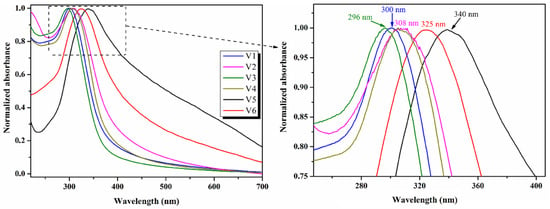
Figure 6.
UV–Vis absorption spectra of pristine CeO2 NPs: V1–V6 samples.
The samples prepared at a basic pH (8, 10, and 12), namely V1–V4, have the absorption maxima in the UVB region of the spectrum (see Table 2). The absorption maximum of V1 nanoparticles (prepared at pH = 8, crystallite size ~12 nm) is at 300 nm, meanwhile the V2 and V4 samples (pH = 10 and 12, respectively) present a small red shift of the maxima at around 308 nm (Figure 6). The red shift of the V4 absorption band is attributed to the increase in the crystallite size of the nanoparticles (~22 nm), meanwhile V2, prepared at pH = 10, besides the absorption maximum red shift, also has a broader absorption band due to the mix of nanoparticles morphologies achieved (spheres, triangles, cubes, a.s.o.), as already presented in the TEM section. In the case of the V3 sample synthesized in same conditions as V2 (pH = 10), although having a longer reaction time (72 h), the obtained nanoparticles have more homogeneous shapes (predominant are nanoparticles with cubic-type morphology—Figure 4) and, consequently, the absorption band is sharper, and the maximum is blue shifted at 296 nm (Figure 6). Furthermore, it can be noticed that V5 and V6 nanoparticles prepared in an acidic medium (pH = 4) have higher values regarding the size of the crystallites (17.5–20 nm) and exhibit the absorption band maxima in the UVA region of the spectra (Table 2).
The absorption band of the V5 sample (3 h reaction time, CeO2 nanoparticles of different shapes) is very broad, with a maximum at λ = 340 nm. The increase in the reaction time to 72 h for the V6 sample leads to the formation of nanoparticles with cubic-type morphology, and this is reflected in the UV–Vis spectrum by the hypsochromic shift of the absorption band, together with its narrowing. Another interesting observation is that the adsorption band edges of the V5 and V6 samples are shifted to longer wavelengths in the visible domain, with V5 and V6 (pH = 4) presenting very broad absorption bands compared to the samples prepared at the basic pH (V1–V4).
The influence of the Co-doping of CeO2 nanoparticles is reflected in the UV–Vis absorption properties, as can be observed from Figure 7. The absorption spectra of the Co-doped CeO2 nanoparticles, V2-Co and V5-Co, have the same curve profile but are shifted by almost 15 nm to shorter wavelengths compared to pristine CeO2 samples, V2 and V5; the band maximum of V2-Co is at λ = 295 nm and the one of V5-Co is at λ = 325 nm. The Co-doping of the CeO2 NPs thus modifies the absorption properties of the nanoparticles.
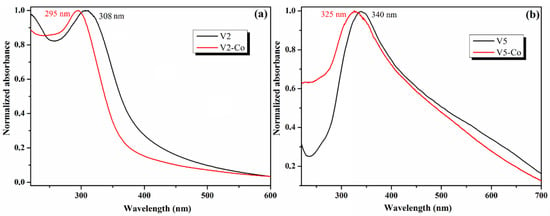
Figure 7.
UV–Vis absorption spectra of V2 samples, pristine and Co-doped (a), and of V5 samples, pristine and Co-doped (b).
Moreover, the diffuse reflectance spectra of pristine and Co-doped CeO2nanoparticles (Figure 8) were registered in order to evaluate the band gap energy of our samples. As can be observed, the color of the pristine CeO2 NPs is pale-yellow, meanwhile Co-doped samples have a dark-brown color, and the chromic change is also reflected by DRS spectra, which show a decrease in reflectance (Figure 8b).
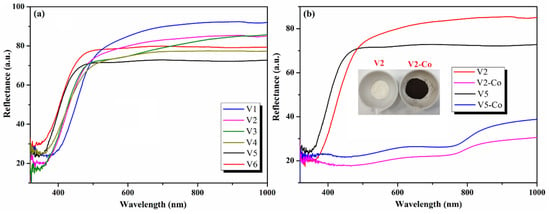
Figure 8.
Reflectance spectra of pristine CeO2 NPs (V1–V6) (a) and of Co-doped CeO2 NPs (V2-Co, V5-Co) comparative to pristine V2 and V5 (b) (Inset: photo of V2 and V2-Co samples).
The band gap energy indicates the threshold for photons to be absorbed and is mainly associated with the photocatalytic activity of the synthesized nanoparticles. The Kubelka–Munk theory in Equation (1) was used to determine the direct band gap values [48,54] of the pristine CeO2 NPs, V1–V6, and of the Co-doped CeO2 NPs, V2-Co and V5-Co.The corresponding plots are shown in Figure 9.
where F(R) = (1 − R)2/2R, h is a Planks constant, υ is the light frequency, A is the absorption coefficient and Eg is the band gap energy.
(hυ F(R))2 = A(hυ − Eg)

Figure 9.
The Kubelka–Munk plots of different CeO2 NPs samples: V1–V6 (a), V2-Co comparative to V2 (b), and V5-Co relative to V5 (c).
The band gap energy values of the V1–V6 samples vary between 3.18 eV and 2.85 eV (Figure 9a) and, depending on the synthesis conditions used for the preparation of the nanoparticles, the calculated Eg values are given in Table 2. V1–V4 samples, prepared in a basic medium, have lower Eg values (2.85–3.02 eV) compared to the V5 and V6 samples (3.18 and 3.14 eV) synthesized in acidic conditions. In this regard, it has been reported that the low band gap energy values of the CeO2 nanoparticles are related to the abundance in oxygen vacancies and Ce3+ species in the nanostructure [55,56,57,58,59], which are furthermore linked to higher light absorption intensity, which, implicitly, could be reflected by the enhancement of the photocatalytic performance. According to these findings, V1–V4 samples synthesized at basic pH are recommended to be used as photocatalysts, since these CeO2 NPs will have higher photocatalytic performance compared to the ones prepared in an acidic medium (V5, V6).
V2, V3, and V4 nanostructures show similar band gap energy values (2.98 and 3.02 eV, respectively), meanwhile V1 has the lowest Eg value, ~2.85 eV, suggesting that these type of CeO2 nanoparticles (achieved at pH = 8) can also be photoexcited by visible light irradiation. The response to the visible light of CeO2 NPs can lead to an enhancement of photocatalytic performance due to the generation of more electron-hole pairs [57], but they can also become potential candidates for photocatalyst under solar light irradiation. Hence, the V1 sample is more suitable for use in photocatalytic applications, rather than other synthesized pristine CeO2 NPs. We can conclude that, by choosing the optimal synthesis parameters, in this case the NH4OH co-reagent, pH = 8, t = 3 h, we can obtain pristine CeO2 NPs with desired values of Eg and sizes for the envisaged application, namely photocatalysis under sunlight.
Furthermore, we investigate the effect of the Co-doping of the CeO2 nanoparticle on the band gap energy values of our samples, which were determined according to Makuła et al. [60]. We choose to use Co as the doping element since it has already been reported in the literature that CeO2 doping with Co could decrease the CeO2 band gap more than other transition metal dopants [61]. The Co-doping of V2 and V5 nanoparticles induces a significant decrease in the band gap energy values of the samples, as presented in Figure 9b,c. The Eg of V2 decreases from 2.98 to 2.02 eV, meanwhile V5’s Eg value is reduced from 3.18 to 2.07 eV by doping procedure. The Co-doping of CeO2 NPs leads to the release of oxygen ions, which favor the reduction inCe4+ to Ce3+; thus, the amount of Ce3+ states in the CeO2 structure increases and induces the formation of energy states located closer to the conduction band and reduces the band gap energy value [62,63]. The other direct band gap of about 1.4 eV identified in the Kubelka–Munk plots for V2-Co and V5-Co corresponds to the wurtzite CoO structure [64]. The narrowing of the band gap energy of CeO2 nanoparticles by Co-doping (~2.02–2.07 eV), along with the size reduction in the nanoparticles, transforms V2-Co and V5-Co samples in visible light-responsive materials and implicitly potential photocatalysts with high performance under sunlight.
Fluorescence spectroscopy offers us valuable information about the photogenerated electron-hole pairs at room temperature in semiconductor particles [52,65]. Generally, the intensity of fluorescence spectra is directly proportional to the ratio of the charge recombination. The fluorescence spectra of pure CeO2 NPs, V1–V6, were measured at two excitation wavelengths, namely at 270 nm and at 325 nm, as shown in Figure 10, and it can be observed that the emission curve profile of CeO2 NPs depends on the excitation wavelength used. At λex = 270 nm (Figure 10a), V2–V4 samples, which have almost the same value of band gap energy (Eg ~ 3.0 eV), displayed a broad emission band, with a maximum at 355 nm. V3 has a reduced fluorescence intensity comparative to V2 and V4, indicating that the recombination process of charge carriers is slower for V3 nanoparticles. V1, V5, and V6 nanoparticles have broader emission bands shifted to shorter wavelengths (~295–325 nm), with a reduced fluorescence intensity for V1.

Figure 10.
Fluorescence spectra of pristine CeO2 NPs (V1–V6) at λex = 270 nm (a) and λex = 325 nm (b).
The slow recombination rate of charge carriers for the V1 sample is an important advantage for the use of CeO2 NPs of this type as photocatalysts, together with their Eg value (2.85 eV). At λex = 325 nm (Figure 10b), all CeO2 samples (V1–V6) have similar emission curve profiles, with sharper bands with emission maxima positioned at: 358 nm, 378 nm, 400 nm, 468 nm, and 532 nm. A closer examination of the 400–500 nm wavelength area (Figure 10b—inset) revealed that emission intensity is lower for the V1 sample, sustaining the same conclusions as above (at λex = 270 nm), according to which V1 nanoparticles present a slow recombination rate of charge carriers, a finding that is in concordance with XRD and TEM results; consequently, they will have improved photocatalytic activity.
The fluorescence intensity of Co-doped CeO2 NPs, V2-Co and V5-Co, is lower than that of the pristine V2 and V5 at both excitation wavelengths λex = 270 nm (Figure 11a) and λex = 325 nm (Figure 11b). The reduction in fluorescence intensity by the Co-doping of CeO2 NPs shows that the charge recombination rate was diminished to the desired point in order to enhance the photocatalytic performance.
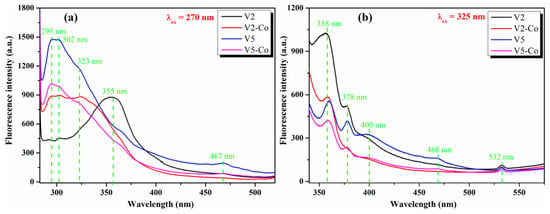
Figure 11.
Fluorescence spectra of Co-doped CeO2 NPs (V2-Co, V5-Co) comparative to pristine V2 and V5 pristine CeO2 NPs at λex = 270 nm (a) and λex = 325 nm (b).
The XRD, TEM, and optical studies of all samples indicate that the best performance as a photocatalyst will be attained by V1 (pH = 8, t = 3h) and by the Co-doped samples, namely V2-Co and V5-Co. The photocatalytic behavior under visible radiation/sunlight of the three types of CeO2 NPs will be presented in detail in our future work, after their immobilization in a cellulose-based matrix, as previously described [48]. The nanoparticles’ immobilization will be a necessary step to confer reusability properties to the materials without having difficulties in their recovery.
4. Conclusions
The present study reports a preparation in various conditions (pH, time, co-reagent variation) of pristine CeO2 nanoparticles and also the preparation of some Co-doped CeO2 samples. All samples were characterized in detail (FTIR, XRD, SEM, EDX, TEM, UV–Vis, and fluorescence spectroscopy) to highlight the differences between them. The nanoparticles with smaller sizes (11–14 nm for V1–V3 samples) were achieved through the reaction realized in basic medium (pH = 8 and 10). The fluorescence investigation also showed that V1 has a slow recombination rate of charge carriers, and the UV–Vis studies revealed that the V1 sample has an Eg value < 3.0 eV (~2.85 eV), meaning that these CeO2 NPs can be photoexcited by photons from a visible domain. Thus, in order to prepare pristine CeO2 NPs suitable for photocatalytic applications under sunlight, with desired values of Eg, small sizes and slow recombination rate of charge carriers, the optimal synthesis parameters recommended are: NH4OH as co-reagent, reaction pH = 8, and reaction time t = 3 h. Moreover, the Co-doping of ceria nanoparticles is also recommended to prepare photocatalysts active under sunlight, since, through the Co-doping of CeO2 NPs (V2-Co and V5-Co), a decrease in the crystallite sizes/dimensions of the nanoparticles (10–12 nm) was achieved, together with the diminution of the charge recombination rate and of Eg values (2.02–2.07 eV).
Author Contributions
Conceptualization, A.L.C.-S. and V.M.; methodology, V.M. and V.P.; validation, A.L.C.-S. and V.M.; formal analysis and investigation, A.L.C.-S., V.P., I.A.D. and V.M.; writing—original draft preparation, A.L.C.-S. and V.M.; writing—review and editing, A.L.C.-S. and V.M.; funding acquisition, A.L.C.-S. All authors have read and agreed to the published version of the manuscript.
Funding
This research was supported by a grant of the Ministry of Research, Innovation and Digitization, CNCS/CCCDI–UEFISCDI, project number PN-III-P1-1.1-TE-2019-1245 (23/27.08.2020), within PNCDI III.
Data Availability Statement
Data presented in this article are available at request from the corresponding author.
Conflicts of Interest
The authors declare no conflict of interest.
References
- Amoresi, R.A.C.; Oliveira, R.C.; Marana, N.L.; De Almeida, P.B.; Prata, P.S.; Zaghete, M.A.; Longo, E.; Sambrano, J.R.; Simões, A.Z. CeO2 nanoparticle morphologies and their corresponding crystalline planes for the photocatalytic degradation of organic pollutants. ACS Appl. Nano Mater. 2019, 2, 6513–6526. [Google Scholar] [CrossRef]
- Trovarelli, A.; Llorca, J. Ceria catalysts at nanoscale: How do crystal shapes shape catalysis? ACS Catal. 2017, 7, 4716–4735. [Google Scholar] [CrossRef]
- Mullins, D.R.; Albrecht, P.M.; Calaza, F. Variations in reactivity on different crystallographic orientations of cerium oxide. Top. Catal. 2013, 56, 1345–1362. [Google Scholar] [CrossRef]
- Ma, Y.; Gao, W.; Zhang, Z.; Zhang, S.; Tian, Z.; Liu, Y.; Ho, J.C.; Qu, Y. Regulating the surface of nanoceria and its applications in heterogeneous catalysis. Surf. Sci. Rep. 2018, 73, 1–36. [Google Scholar] [CrossRef]
- Álvarez-Asencio, R.; Corkery, R.W.; Ahniyaz, A. Solventless synthesis of cerium oxide nanoparticles and their application in UV protective clear coatings. RSC Adv. 2020, 10, 14818–14825. [Google Scholar] [CrossRef]
- Chen, C.Y.; Chang, K.H.; Chiang, H.Y.; Shih, S.J. Preparation of a porous ceria coating for a resistive oxygen sensor. Sens. Actuators B Chem. 2014, 204, 31–41. [Google Scholar] [CrossRef]
- Li, P.; Chen, X.; Li, Y.; Schwank, J.W. A review on oxygen storage capacity of CeO2 -based materials: Influence factors, measurement techniques, and applications in reactions related to catalytic automotive emissions control. Catal. Today 2019, 327, 90–115. [Google Scholar] [CrossRef]
- Khan, A.J.; Hanif, M.; Javed, M.S.; Hussain, S.; Zhong, W.; Saleem, M.; Liu, Z. Energy storage properties of hydrothermally processed, nanostructured, porous CeO2 nanoparticles. J. Electroanal. Chem. 2020, 865, 114158. [Google Scholar] [CrossRef]
- Divya, T.; Anjali, C.; Sunajadevi, K.R.; Anas, K.; Renuka, N.K. Influence of hydrothermal synthesis conditions on lattice defects in cerium oxide. J. Solid State Chem. 2021, 300, 122253. [Google Scholar] [CrossRef]
- Xu, B.; Zhang, Q.; Yuan, S.; Zhang, M.; Ohno, T. Morphology control and characterization of broom-like porous CeO2. Chem. Eng. J. 2015, 260, 126–132. [Google Scholar] [CrossRef] [Green Version]
- Ferreira, N.S.; Angélica, R.S.; Marques, V.B.; De Lima, C.C.O.; Silva, M.S. Cassava-starch-assisted sol-gel synthesis of CeO2 nanoparticles. Mater. Lett. 2016, 165, 139–142. [Google Scholar] [CrossRef]
- Tamizhdurai, P.; Sakthinathan, S.; Chen, S.M.; Shanthi, K.; Sivasanker, S.; Sangeetha, P. Environmentally friendly synthesis of CeO2 nanoparticles for the catalytic oxidation of benzyl alcohol to benzaldehyde and selective detection of nitrite. Sci. Rep. 2017, 7, 46372. [Google Scholar] [CrossRef] [PubMed]
- Choudhary, S.; Sahu, K.; Bisht, A.; Singhal, R.; Mohapatra, S. Template-free and surfactant-free synthesis of CeO2nanodiscs with enhanced photocatalytic activity. Appl. Surf. Sci. 2020, 503, 144102. [Google Scholar] [CrossRef]
- Ko, H.H.; Yang, G.; Cheng, H.Z.; Wang, M.C.; Zhao, X. Growth and optical properties of cerium dioxide nanocrystallites prepared by coprecipitation routes. Ceram. Int. 2014, 40, 4055–4064. [Google Scholar] [CrossRef]
- Pang, J.H.; Liu, Y.; Li, J.; Yang, X.J. Solvothermal synthesis of nano-CeO2 aggregates and its application as a high-efficient arsenic adsorbent. Rare Met. 2019, 38, 73–80. [Google Scholar] [CrossRef]
- Shlapa, Y.; Sarnatskaya, V.; Timashkov, I.; Yushko, L.; Antal, I.; Gerashchenko, B.; Nychyporenko, I.; Belous, A.; Nikolaev, V.; Timko, M. Synthesis of CeO2 nanoparticles by precipitation in reversal microemulsions and their physical-chemical and biological properties. Appl. Phys. A Mater. Sci. Process. 2019, 125, 412. [Google Scholar] [CrossRef]
- He, J.; Zhou, L.; Liu, J.; Yang, L.; Zou, L.; Xiang, J.; Dong, S.; Yang, X. Modulation of surface structure and catalytic properties of cerium oxide nanoparticles by thermal and microwave synthesis techniques. Appl. Surf. Sci. 2017, 402, 469–477. [Google Scholar] [CrossRef]
- Mishra, S.; Soren, S.; Debnath, A.K.; Aswal, D.K.; Das, N.; Parhi, P. Rapid microwave—Hydrothermal synthesis of CeO2 nanoparticles for simultaneous adsorption/photodegradation of organic dyes under visible light. Optik 2018, 169, 125–136. [Google Scholar] [CrossRef]
- Polychronopoulou, K.; Zedan, A.F.; Katsiotis, M.S.; Baker, M.A.; AlKhoori, A.A.; AlQaradawi, S.Y.; Hinder, S.J.; AlHassan, S. Rapid microwave assisted sol-gel synthesis of CeO2 and CexSm1-xO2 nanoparticle catalysts for CO oxidation. J. Mol. Catal. 2017, 428, 41–55. [Google Scholar] [CrossRef]
- Qiao, Z.A.; Wu, Z.; Dai, S. Shape-controlled ceria-based nanostructures for catalysis applications. ChemSusChem 2013, 6, 1821–1833. [Google Scholar] [CrossRef]
- Kurian, M. Cerium oxide based materials for water treatment-A review. J. Environ. Chem. Eng. 2020, 8, 104439. [Google Scholar] [CrossRef]
- Nyoka, M.; Choonara, Y.E.; Kumar, P.; Kondiah, P.P.D.; Pillay, V. Synthesis of cerium oxide nanoparticles using various methods: Implications for biomedical applications. Nanomaterials 2020, 10, 242. [Google Scholar] [CrossRef] [PubMed] [Green Version]
- Calvache-Muñoz, J.; Prado, F.A.; Rodríguez-Páez, J.E. Cerium oxide nanoparticles: Synthesis, characterization and tentative mechanism of particle formation. Colloids Surf. A Physicochem. Eng. Asp. 2017, 529, 146–159. [Google Scholar] [CrossRef]
- Krishnan, A.; Sreeremya, T.S.; Ghosh, S. Size-tunable hydrophilic cerium oxide nanoparticles as a “turn-on” fluorescence sensor for the rapid detection of ultralow concentrations of Vitamin C. RSC Adv. 2016, 6, 53550–53559. [Google Scholar] [CrossRef]
- Dos Santos, A.P.B.; Dantas, T.C.M.; Costa, J.A.P.; Souza, L.D.; Soares, J.M.; Caldeira, V.P.S.; Araújo, A.S.; Santos, A.G.D. Formation of CeO2 nanotubes through different conditions of hydrothermal synthesis. Surf. Interfaces 2020, 21, 100746. [Google Scholar] [CrossRef]
- MohdFadzil, N.A.; Ab Rahim, M.H.; PragasManiam, G. Brief review of ceria and modified ceria: Synthesis and application. Mater. Res. Express 2018, 5, 085019. [Google Scholar] [CrossRef] [Green Version]
- Mal, D.; Balouch, A.; Sirajuddin; Abdullah; Mahar, A.M.; Pato, A.H.; Kumar, S.; Lal, S.; Kumar, A. Synthesis and catalytic practicality of CeO2 nanoparticle: An excellent heterogenous candidate for 4-nitrophenol reduction. Appl. Nanosci. 2020, 10, 3443–3455. [Google Scholar] [CrossRef]
- Li, H.; Wang, G.; Zhang, F.; Cai, Y.; Wang, Y.; Djerdj, I. Surfactant-assisted synthesis of CeO2 nanoparticles and their application in wastewater treatment. RSC Adv. 2012, 2, 12413–12423. [Google Scholar] [CrossRef]
- Eka Putri, G.; Rilda, Y.; Syukri, S.; Labanni, A.; Arief, S. Highly antimicrobial activity of cerium oxide nanoparticles synthesized using Moringa oleifera leaf extract by a rapid green precipitation method. J. Mater. Res. Technol. 2021, 15, 2355–2364. [Google Scholar] [CrossRef]
- Kusmierek, E. A CeO2 semiconductor as a photocatalytic and photoelectrocatalytic material for the remediation of pollutants in industrial wastewater: A review. Catalysts 2020, 10, 1435. [Google Scholar] [CrossRef]
- Choudhury, B.; Chetri, P.; Choudhury, A. Annealing temperature and oxygen-vacancy-dependent variation of lattice strain, band gap and luminescence properties of CeO2 nanoparticles. J. Exp. Nanosci. 2015, 10, 103–114. [Google Scholar] [CrossRef] [Green Version]
- Sun, C.; Li, H.; Chen, L. Nanostructured ceria-based materials: Synthesis, properties, and applications. Energy Environ. Sci. 2012, 5, 8475–8505. [Google Scholar] [CrossRef]
- Tatar, B.; Sam, E.D.; Kutlu, K.; Ürgen, M. Synthesis and optical properties of CeO2 nanocrystalline films grown by pulsed electron beam deposition. J. Mater. Sci. 2008, 43, 5102–5108. [Google Scholar] [CrossRef]
- Ortega, P.P.; Hangai, B.; Moreno, H.; Rocha, L.S.R.; Ramírez, M.A.; Ponce, M.A.; Longo, E.; Simões, A.Z. Tuning structural, optical, and gas sensing properties of ceria-based materials by rare-earth doping. J. Alloys Compd. 2021, 888, 161517. [Google Scholar] [CrossRef]
- Qi, Y.; Ye, J.; Zhang, S.; Tian, Q.; Xu, N.; Tian, P.; Ning, G. Controllable synthesis of transition metal ion-doped CeO2 micro/nanostructures for improving photocatalytic performance. J. Alloys Compd. 2019, 782, 780–788. [Google Scholar] [CrossRef]
- Ma, R.; Zhang, S.; Wen, T.; Gu, P.; Li, L.; Zhao, G.; Niu, F.; Huang, Q.; Tang, Z.; Wang, X. A critical review on visible-light-response CeO2-based photocatalysts with enhanced photooxidation of organic pollutants. Catal. Today 2019, 335, 20–30. [Google Scholar] [CrossRef]
- Gnanam, S.; Rajendran, V. Facile sol-gel preparation of Cd-doped cerium oxide (CeO2) nanoparticles and their photocatalytic activities. J. Alloys Compd. 2018, 735, 1854–1862. [Google Scholar] [CrossRef]
- Podasca, V.-E.; Damaceanu, M.-D. Photopolymerized films with ZnO and doped ZnO particles used as efficient photocatalysts in malachite green dye decomposition. Appl. Sci. 2020, 10, 1954. [Google Scholar] [CrossRef] [Green Version]
- Dong, B.; Li, L.; Dong, Z.; Xu, R.; Wu, Y. Fabrication of CeO2 nanorods for enhanced solar photocatalysts. Int. J. Hydrogen Energy 2018, 43, 5275–5282. [Google Scholar] [CrossRef]
- Li, S.; Wang, N.; Yue, Y.; Wang, G.; Zu, Z.; Zhang, Y. Copper doped ceria porous nanostructures towards a highly efficient bifunctional catalyst for carbon monoxide and nitric oxide elimination. Chem. Sci. 2015, 6, 2495–2500. [Google Scholar] [CrossRef] [Green Version]
- Akbari, A.; Khammar, M.; Taherzadeh, D.; Rajabian, A.; Khorsand Zak, A.; Darroudi, M. Zinc-doped cerium oxide nanoparticles: Sol-gel synthesis, characterization, and investigation of their in vitro cytotoxicity effects. J. Mol. Struct. 2017, 1149, 771–776. [Google Scholar] [CrossRef]
- Suresh, R.; Ponnuswamy, V.; Mariappan, R. Effect of annealing temperature on the microstructural, optical and electrical properties of CeO2 nanoparticles by chemical precipitation method. Appl. Surf. Sci. 2013, 273, 457–464. [Google Scholar] [CrossRef]
- Ortega, P.P.; Rocha, L.S.R.; Cortés, J.A.; Ramirez, M.A.; Buono, C.; Ponce, M.A.; Simões, A.Z. Towards carbon monoxide sensors based on europium doped cerium dioxide. Appl. Surf. Sci. 2019, 464, 692–699. [Google Scholar] [CrossRef]
- Bell, A.T. The impact of nanoscience on heterogeneous catalysis. Science 2003, 299, 1688–1691. [Google Scholar] [CrossRef] [PubMed] [Green Version]
- Shang, M.; Wang, W.; Sun, S.; Zhou, L.; Zhang, L. Bi2WO6 nanocrystals with high photocatalytic activities under visible light. J. Phys. Chem. C 2008, 112, 10407–10411. [Google Scholar] [CrossRef]
- Ranjith, K.S.; Saravanan, P.; Chen, S.H.; Dong, C.L.; Chen, C.L.; Chen, S.Y.; Asokan, K.; Kumar, R.T.R. Enhanced room-temperature ferromagnetism on Co-doped CeO2 nanoparticles: Mechanism, electronic and optical properties. J. Phys. Chem. C 2014, 118, 27039–27047. [Google Scholar] [CrossRef]
- Hancock, M.L.; Yokel, R.A.; Beck, M.J.; Calahan, J.L.; Jarrells, T.W.; Munson, E.J.; Olaniyan, G.A.; Grulke, E.A. The characterization of purified citrate-coated cerium oxide nanoparticles prepared via hydrothermal synthesis. Appl. Surf. Sci. 2021, 535, 147681. [Google Scholar] [CrossRef]
- Melinte, V.; Chibac-Scutaru, A.L.; Culica, M.E.; Coseri, S. Mineralization versus photoreduction of 4-nitrophenol under the influence of surface functionalized CeO2 nanoparticles, hosted by versatile cellulose supports. Appl. Surf. Sci. 2021, 565, 150494. [Google Scholar] [CrossRef]
- Choudhury, B.; Chetri, P.; Choudhury, A. Oxygen defects and formation of Ce3+ affecting the photocatalytic performance of CeO2 nanoparticles. RSC Adv. 2014, 4, 4663–4671. [Google Scholar] [CrossRef]
- Soni, S.; Vats, V.S.; Kumar, S.; Dalela, B.; Mishra, M.; Meena, R.S.; Gupta, G.; Alvi, P.A.; Dalela, S. Structural, optical and magnetic properties of Fe-doped CeO2 samples probed using X-ray photoelectron spectroscopy. J. Mater. Sci. Mater. Electron. 2018, 29, 10141–10153. [Google Scholar] [CrossRef]
- Goharshadi, E.K.; Samiee, S.; Nancarrow, P. Fabrication of cerium oxide nanoparticles: Characterization and optical properties. J. Colloid Interface Sci. 2011, 356, 473–480. [Google Scholar] [CrossRef] [PubMed]
- Khan, M.E.; Khan, M.M.; Cho, M.H. Ce3+-ion, surface oxygen vacancy, and visible light-induced photocatalytic dye degradation and photocapacitive performance of CeO2-graphene nanostructures. Sci. Rep. 2017, 7, 5928. [Google Scholar] [CrossRef] [PubMed] [Green Version]
- Wang, L.; Meng, F.; Li, K.; Lu, F. Characterization and optical properties of pole-like nano-CeO2 synthesized by a facile hydrothermal method. Appl. Surf. Sci. 2013, 286, 269–274. [Google Scholar] [CrossRef]
- Kubelka, P. New contributions to the optics of intensely light-scattering materials. Part II: Nonhomogeneous layers. J. Opt. Soc. Am. 1954, 44, 330–335. [Google Scholar] [CrossRef]
- Lu, X.; Zheng, D.; Zhang, P.; Liang, C.; Liu, P.; Tong, Y. Facile synthesis of free-standing CeO2 nanorods for photoelectrochemical applications. Chem. Commun. 2010, 46, 7721–7723. [Google Scholar] [CrossRef]
- Choudhury, B.; Choudhury, A. Ce3+ and oxygen vacancy mediated tuning of structural and optical properties of CeO2 nanoparticles. Mater. Chem. Phys. 2012, 131, 666–671. [Google Scholar] [CrossRef]
- Ansari, S.A.; Khan, M.M.; Ansari, M.O.; Kalathil, S.; Lee, J.; Cho, M.H. Band gap engineering of CeO2 nanostructure by electrochemically active biofilm for visible light applications. RSC Adv. 2014, 4, 16782–16791. [Google Scholar] [CrossRef]
- Pastor-Pérez, L.; Ramos-Fernández, E.V.; Sepúlveda-Escribano, A. Effect of the CeO2 synthesis method on the behaviour of Pt/CeO2 catalysis for the water-gas shift reaction. Int. J. Hydrogen Energy 2019, 44, 21837–21846. [Google Scholar] [CrossRef]
- Lykaki, M.; Stefa, S.; Carabineiro, S.A.C.; Soria, M.A.; Madeira, L.M.; Konsolakis, M. Shape effects of ceria nanoparticles on the water-gas shift performance of CuOx/CeO2 catalysts. Catalysts 2021, 11, 753. [Google Scholar] [CrossRef]
- Makuła, P.; Pacia, M.; Macyk, W. How to correctly determine the band gap energy of modified semiconductor photocatalysts based on UV-Vis spectra. J. Phys. Chem. Lett. 2018, 9, 6814–6817. [Google Scholar] [CrossRef] [Green Version]
- Yue, L.; Zhang, X.M. Structural characterization and photocatalytic behaviors of doped CeO2 nanoparticles. J. Alloys Compd. 2009, 475, 702–705. [Google Scholar] [CrossRef]
- Saranya, J.; Ranjith, K.S.; Saravanan, P.; Mangalaraj, D.; Rajendra Kumar, R.T. Cobalt-doped cerium oxide nanoparticles: Enhanced photocatalytic activity under UV and visible light irradiation. Mater. Sci. Semicond. Process. 2014, 26, 218–224. [Google Scholar] [CrossRef]
- Zimou, J.; Nouneh, K.; Hsissou, R.; El-habib, A.; El Gana, L.; Talbi, A.; Beraich, M.; Lotfi, N.; Addou, M. Structural, morphological, optical, and electrochemical properties of Co-doped CeO2 thin films. Mater. Sci. Semicond. Process. 2021, 135, 106049. [Google Scholar] [CrossRef]
- Wang, Y.; Ge, H.X.; Chen, Y.P.; Meng, X.Y.; Ghanbaja, J.; Horwat, D.; Pierson, J.F. Wurtzite CoO: A direct band gap oxide suitable for a photovoltaic absorber. Chem. Commun. 2018, 54, 13949–13952. [Google Scholar] [CrossRef]
- Ansari, S.A.; Khan, M.M.; Kalathil, S.; Nisar, A.; Lee, J.; Cho, M.H. Oxygen vacancy induced band gap narrowing of ZnO nanostructures by an electrochemically active biofilm. Nanoscale 2013, 5, 9238–9246. [Google Scholar] [CrossRef]
Publisher’s Note: MDPI stays neutral with regard to jurisdictional claims in published maps and institutional affiliations. |
© 2022 by the authors. Licensee MDPI, Basel, Switzerland. This article is an open access article distributed under the terms and conditions of the Creative Commons Attribution (CC BY) license (https://creativecommons.org/licenses/by/4.0/).